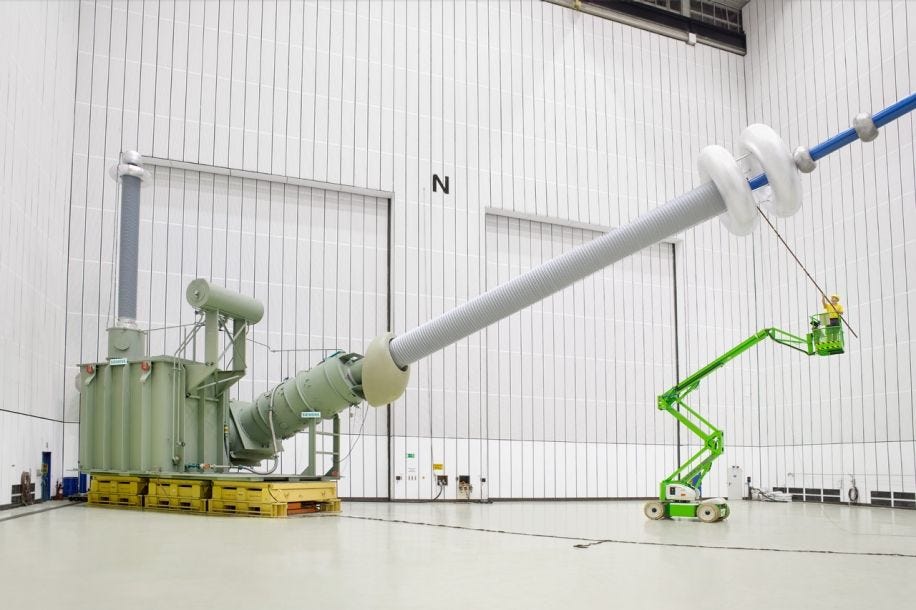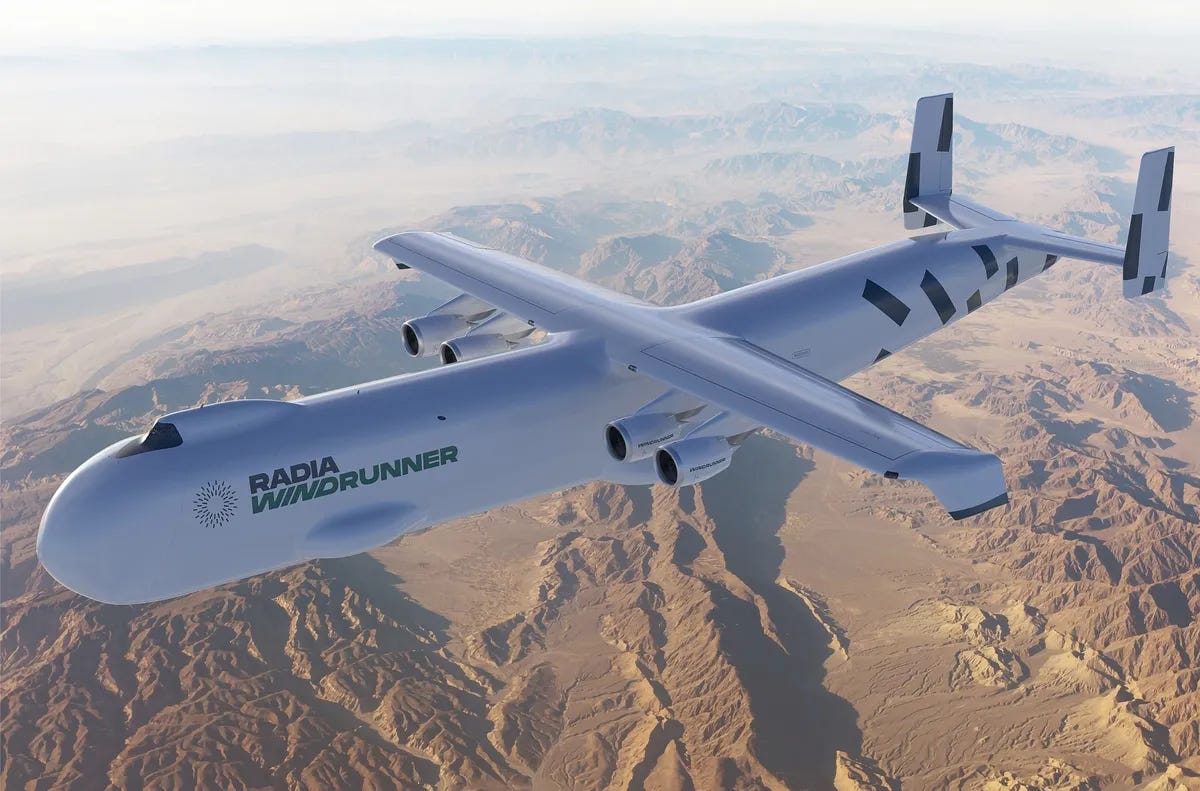Reading List 09/13/2025
3D printing company Icon, transporting wind turbine blades on the largest airplane in the world, insurers funding cloud seeding, earthquakes in the Atlantic Ocean, and more.

Welcome to the reading list, a weekly roundup of news and links related to buildings, infrastructure and industrial technology. This week we look at 3D printing company Icon, transporting wind turbine blades on the largest airplane in the world, insurers funding cloud seeding, earthquakes in the Atlantic Ocean, and more. Roughly 2/rds of the reading list is paywalled, so for full access become a paid subscriber.
Manhattan Project reading list
This week’s essay was an 11,000 word behemoth on the engineering history of the Manhattan Project. If you somehow made it through all that and are eager for more, here’s the best sources I found on the topic:
The Making of the Atomic Bomb by Richard Rhodes - Pulitzer Prize winning 880 page opus on the history of building the bomb. A surprisingly large chunk of this book is dedicated to the early discoveries in nuclear physics that ended up leading to the bomb, and there’s less than you might expect on the nuts and bolts of actually building it. Hanford, for instance, is only mentioned on something like 11 pages of the entire book. Nevertheless an essential read. This book references many of the books below.
Now It Can Be Told by Leslie Groves - An autobiographical account of Groves’ efforts on leading the Manhattan Project. Lots of fascinating detail on the difficulties in getting the various plants built, as well as lots of other Manhattan Project efforts you don’t typically hear about (such as studying and sabotaging German nuclear efforts).
Critical Assembly: A Technical History of Los Alamos during the Oppenheimer Years, 1943-1945 - Exactly what the title says, this is an extremely detailed history of the various technical challenges that needed to be overcome at Los Alamos to build the atomic bomb. This book was coauthored by historian of science Lillian Hoddeson, co-author of one of my favorite books, “Crystal Fire”, a history of the transistor.
Manhattan District History: Project Y - Critical Assembly is excellent, but it's so thorough and detailed that it makes it hard to step back and see the Los Alamos efforts from a whole. This is the “official” history of the efforts at Los Alamos, written in the 1940s shortly after the end of WWII. It’s a good survey of everything that went on at Los Alamos, though it mostly lacks the detail of “Critical Assembly”.
Manhattan: The Army and the Bomb - This is the official history of the army’s efforts on the Manhattan Project, and is the best source I found for what it actually took to build the facilities at Oak Ridge and Hanford.
New York Times on 3D Printing company Icon
The New York Times has an article about 3D building printing company Icon, which we’ve written about previously.
ICON doesn’t publicly disclose its valuation, but it’s estimated to be around $1 billion. The company is based in Austin and is opening a second permanent office in Miami this fall. It is not the only company in this market, but in its size and scope — including a 100-home neighborhood in Texas that is the world’s only 3-D printed community — it is a leader in this emerging space.
“A big chunk of the world still doesn’t believe it, so there’s still this ground game of belief,” said Mr. Ballard, 43. “We just have to continue to put our work out in the world, and see it inhabited.”
The article has surprisingly little in the way of new information, but there’s a few interesting details, such as that Icon’s current Vulcan printers are estimated to cost $500,000 apiece. The $1 billion estimated valuation is a substantial decline from a previously estimated $2 billion valuation and is less than twice the value of the more than $500 million in funding it’s raised. And Icon still seems like it's been very slow to pick up new projects. In April of 2024 I noted that it hadn’t announced a new project in more than a year. A year and a half later, the only new project on its website is a 12-unit development in Austin; the NYT article notes another 60 unit tiny house development for the homeless in Austin is on the way. There’s also not much on its new “Phoenix” printer, other than it plans to deploy it in the next two years.
Despite the enthusiastic tone of the article (it reads like a press release), with what appears to be a declining valuation and little in the way of new projects, things seem to be going poorly for Icon.
SpaceX buys EchoStar spectrum
SpaceX is spending $17 billion to buy spectrum licenses from “premier global satellite communication provider” EchoStar, possibly as part of an effort to offer satellite internet service direct to devices like phones. Via Bloomberg:
The deal is also a boon for SpaceX, which has been trying to build out a direct-to-device satellite option. The agreement will combine EchoStar spectrum with SpaceX’s rocket launch and satellite capabilities “to realize the direct-to-cell vision in a more innovative, economical and faster way,” Hamid Akhavan, EchoStar chief executive officer, said in the statement.
Satellite operators like SpaceX seeking to provide mobile service from space usually need to team up with at least one company that holds ground-based mobile licenses. SpaceX currently has a partnership with T-Mobile US Inc., but Monday’s spectrum acquisition would allow it to offer its own offerings more independently.
Shares of other wireless carriers fell on the news. T-Mobile was down 4.1%, while Verizon Communications Inc. was down 2.4% and AT&T was down 3.4%.
Apparently SpaceX has been after this spectrum for a while. On his substack Synthetic Wisdom, Tim McDonald explains in a post from May of this year a bit more about the spectrum license awarded, why it’s important, and whether it can actually be used for direct to device service:
Let's start with what's at stake. The AWS-4 band (2000-2020 MHz and 2180-2200 MHz) represents 40 MHz of valuable S-band spectrum currently licensed to EchoStar (formerly Dish Network). This spectrum sits in the sweet spot for satellite communications while still being potentially usable for terrestrial services.
As of May 2025, this spectrum has become the center of a regulatory battle that could reshape the satellite Direct-to-Device (D2D) market:
"I have directed agency staff to begin a review of EchoStar's compliance with its federal obligations to provide 5G service throughout the United States per the terms of its federal spectrum licenses," FCC Chairman Brendan Carr wrote in a May 9 letter to EchoStar Chairman Charles Ergen.
The timing is no coincidence. SpaceX has been aggressively lobbying the FCC, claiming that EchoStar is warehousing this valuable spectrum. In an unprecedented move, SpaceX even deployed its own satellites to measure spectrum utilization, claiming EchoStar uses "less than 5% of what would be expected from an actual wireless network operator."
Turbine blade transport plane
IEEE Spectrum has an article about Radia, a company planning on building the world’s largest airline for the transportation of wind turbine blades. Wind turbines gain economies of scale by making them physically larger, but eventually the blades become too big to transport in one piece over land (thus, you tend to see larger offshore turbines than onshore ones). The solution? Transport turbine blades via enormous airplane:
The world’s largest airplane, when it’s built, will stretch more than a football field from tip to tail. Sixty percent longer than the biggest existing aircraft, with 12 times as much cargo space as a 747, the behemoth will look like an oil tanker that’s sprouted wings—aeronautical engineering at a preposterous scale.
Called WindRunner, and expected by 2030, it’ll haul just one thing: massive wind-turbine blades. In most parts of the world, onshore wind-turbine blades can be built to a length of 70 meters, max. This size constraint comes not from the limits of blade engineering or physics; it’s transportation. Any larger and the blades couldn’t be moved over land, since they wouldn’t fit through tunnels or overpasses, or be able to accommodate some of the sharper curves of roads and rails.
So the WindRunner’s developer, Radia of Boulder, Colo., has staked its business model on the idea that the only way to get extralarge blades to wind farms is to fly them there. “The companies in the industry…know how to make turbines that are the size of the Eiffel Tower with blades that are longer than a football field,” says Mark Lundstrom, Radia’s founder and CEO. “But they’re just frustrated that they can’t deploy those machines [on land].”


